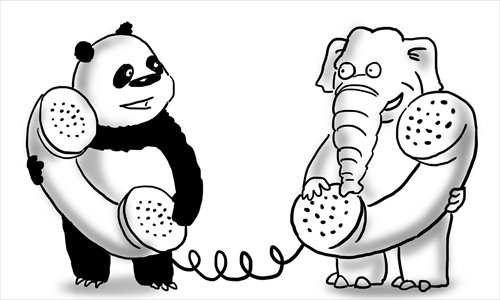Pragmatic approach best when establishing Sino-Indian military hotline

Illustration: Liu Rui/GT
China and India have once again revived their perennial interest in setting up a hotline, this time between their two militaries. In 2008, they set up a hotline between two foreign ministers, which was only briefly used. In 2010 the two sides agreed to set up another hotline between their two heads of state. But neither project seems to have helped in recent misunderstandings.
In November 2013, in their hurriedly-agreed yet ambitious Border Defense Cooperation Agreement (BDCA), China and India had again committed themselves to a list of confidence-building mechanism including considering "establishing a hotline between the military headquarters of the two countries."
Now last month, in his debut visit to Beijing, Indian Defense Minister Manohar Parrikar was quoted saying, "The issue should be closed within one or two months." But again, what the Indian media saw as "a whisker away" has since come under deep study by the concerned departments.
Various recent events have seen both governments put on the defensive. It is common wisdom today that there is an urgent need for New Delhi and Beijing to set up direct hotlines at various levels to ensure timely damage limitation over issues like recent visa flip-flops or explosive public debates over intended or unintended border transgressions by both sides that rapidly go viral.
Chinese and Indian youth are online like never before, and often disconnected from facts even as they're connected to other angry young people. Even officials and politicians have to maintain a grueling pace with multiple engagements and often face each other in various bilateral and multilateral settings where they need real time connectivity and information all the time. Ensuring peace and tranquility in their sensitive border regions in such a brave new world, both sides no doubt need a direct hotline between their militaries to help resolve problems and synchronize viewpoints.
At the same time, setting up hotlines is not going to be a magic wand that will resolve all difficulties. Indeed adopting a pragmatic approach may actually help both sides overcome various unfounded anxieties and also avoid overreactions and procrastinations.
The history of hotlines tells us that, like most other tools, the direct call is effective only when the leadership wants to make them effective. The history of hotlines goes back to the famous Cuban Missile crisis of 1962, when 13 days of nuclear brinkmanship between the US and the Soviet Union ended with both sides setting up a teleprinter hotline between Moscow and Washington. This hotline was first put to use by then president Lyndon Johnson during the 1967 Six Day War in Middle-East to appraise then Soviet premier Alexei Kosygin about the US decision to send the Air Force into the Mediterranean. This was later labelled as a watershed event that was to trigger an era of detente.
On the other hand, the Seoul-Pyongyang hotline set up in August 1972 revived telephonic connectivity between the two Koreas broken since the Korean War (1950-53). But during 2013 tensions with South Korea and the US, Pyongyang disconnected this hotline which has since remained non-functional. India and Pakistan had also set up hotline between their militaries following their 1971 war, used extensively during the 1998 nuclear tests and to keep each other informed of missile launches, but not yet tested in war.
The key is pragmatism. Too much publicity and expectations about a hotline will make negotiating its details complicated and in future it could also appear ineffective in resolving crisis. Hotlines will not wave a magic wand but are only a tool for showing peaceful intent and for creating positive atmospherics for expanding goodwill.
The author is professor at School of International Studies, Jawaharlal Nehru University, New Delhi. opinion@globaltimes.com.cn